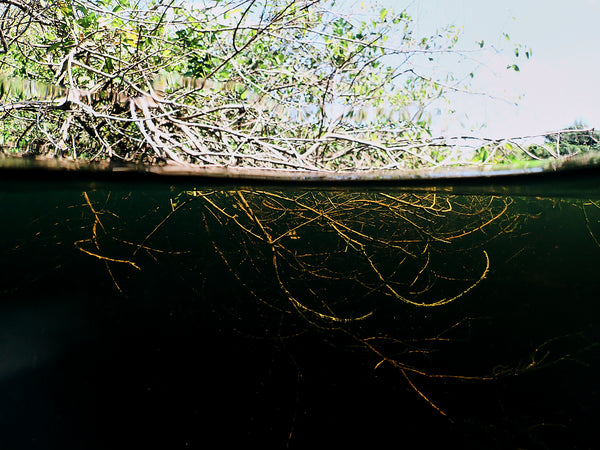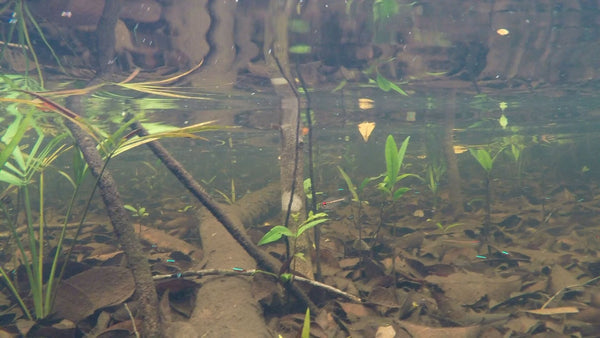- Continue Shopping
- Your Cart is Empty
Lessons learned as the waters recede...
As we've discussed many times, there are some remarkably compelling environments which occur in Nature when rain causes rivers to overflow, inundating the terrestrial environment, and transforming it into an aquatic ecosystem.
These transformational habitats become home to numerous species of fishes and other aquatic life forms as they migrate into the newly forged underwater biome. It's a dynamic habitat, ever-changing as the inundation period progresses.

The water level can rise as much as 10 meters (30 feet) in a given inundation cycle. Obviously, when you're talking about an influx of water of that magnitude, it's a significant event. And it impacts the terrestrial vegetation profoundly. The upper parts of the larger trees in the inundated forests remain above the flood water, while younger trees of the same species and the shrubs remain fully submerged up to a few months each year before the waters ultimately recede.
And that's where it gets really interesting!

We talk a lot about the leaves which fall off the trees into the water. What about those which remain on the trees during the seasonal flooding.
How do the trees and other vegetation survive this inundation?
I mean, while submerged, the leaves on these plants are exposed to a hypoxic (low or depleted oxygen ), or even anoxic (devoid of oxygen) environment. And yet, they remain intact. After an inundation period which can last several months, the leaves which remain on the trees appear to be capable of resuming their primary function. One study determined that, "...at least the majority of the leaves not shed at the beginning of the inundation remain functionally capable, at least when the water depth at which they remain does not exceed 1.5 m."

Ohh. That's cool!
And interestingly, there are other distinctions between what happens in the whitewater-inundated Várzea habitat, versus those which occur in the blackwater-inundated Igapo: Some of those in the Várzea are only lightly coated with sediment, while some in the Igapo are covered only by spicules (small skeletal elements) from freshwater sponges. (don't get me started on freshwater sponges! I mean, man...)

Interestingly, in a study of the leaves of around 20 different species of trees found in a Varzea habitat in Brazil revealed that they possess an epidermal surface structure that's similar to...wait for it...rice plants! Of course, rice plants grow partially submerged, right? This epidermal structure permits a film of air to adhere to the surface when the leaves are first submerged at the beginning of the aquatic phase.
Now, stick with me here.
This is thought by scientists to be an adaptation by the leaves to allow them to survive underwater or periods of time. What this means is that gas exchange occurs between the water and air trapped in the leaves. Carbon dioxide can, under a sort of "partial pressure", enter the leaf structure, leave solution, and enter the leaf openings in the form of gas.
In short, the stomata (minute pores in the epidermis of the leaf or stem of a plant) are protected by heavy waxes, or by a covering of cells against infiltration by water. And the trapped air in these structures permits a low level of photosynthesis to occur under water in the presence of a sufficient light.
Okay, that's freakin' cool.

And yeah, as the waters recede, these trees and plants not only bounce back- they continue to grow and thrive. They've adapted to these seasonal cycles of inundation and desiccation, supporting the ebb and flow of life both above and below the water.

So, what are the implications for us as hobbyists?
For one thing, it means that some terrestrial plants are quite adaptable to submersion for short periods of time. Could this be worth experimenting with in aquaria? Like, doing the "Urban Igapo" thing, starting off with a terrestrial habitat, and flooding it with water for some brief period of time, while utilizing plants that appear to have a waxy coating on their leaves.
Maybe?
I mean, I could be way off here, but it's a starting point, right? Perhaps those with horticulture backgrounds, or simply houseplant lovers might have a lot more to add to this conversation. In the mean time, I think that this might be a good avenue to explore, huh?

A simple idea based on a hunch and an anecdotal observation from Nature, but a good rationale for the possibility for utilizing terrestrial houseplants in our aquarium experiment! It sort of reminds me of the admonitions that you see about that "aquarium plant" which you see at the "big-box" pet store that is really a terrestrial plant, and that it, "...won't survive long term underwater..."
Yeah, but it might survive the "short term" underwater, right?

We can use those types of crazy hobby culture "no-no's" as an impetus to explore possibilities...
It's stuff like that which keeps me fascinated. It's why I've been experimenting with various grass species in my "Urban Igapo" habitats, and have seen long-term survivability/viability in several species after sprouting, growing, and then being submerged for a period of time, and then continuing to survive as the water recedes.
What's the lesson here?

Many trees, grasses, and plants can adapt to survive the inundation, and resume their growth when the terrestrial conditions return. Nature strikes a remarkable balance between two dramatically different habitats. The relationship between land and water is intimate, dynamic, and interwoven.
There's a lot to take away here.
These interesting points from scientific studies can fuel our own hobby-level aquarium work. And the experiments can be quite simple, and still yield impressive and interesting results!

We favor terrestrial plants- and grasses-grown from seed, to start the "cycle."
SO, those of you who are ready to downplay the significance of experimenting with this stuff because "people have done 'dry start' planted tanks for years" , take comfort in the fact that I recognize that, and acknowledge that we're taking a slightly different approach here, okay?

We all possess the "skill set" to explore this unique avenue, and to make interesting and useful observations that will contribute mightily to the body of knowledge of the captive representation of these habitats.
You just have to innovate, and be willing to do a little busy work. You can keep it incredibly simple, and just utilize a small tank. You must be patient, observant, and curious.

There are so many possibilities here...
As I mentioned in a piece back in 2019, it literally, "...could create an entirely new 'sub-hobby' within the aquatic hobby...not just biotope replication- biotope 'operation!' The idea of a '365 Dynamic Aquatic Display'- what we've dubbed the 'Urban Igapo'- has never been more approachable! And you can, as the name implies- recreate it in the comfort of your own home."
Did I just quote myself?
Yeah.
Damn, that was cool!
As always, turn to Nature as it really is for your examples, and study, replicate, and innovate from there.

Let's see some of your experiments. Let's venture out into some deeper water and new ideas. It's a big win for the aquarium hobby!
Stay innovative. Stay excited. Stay curious. Stay experimental. Stay observant. Stay diligent...
And Stay Wet.
Scott Fellman
Tannin Aquatics






Scott Fellman
Author